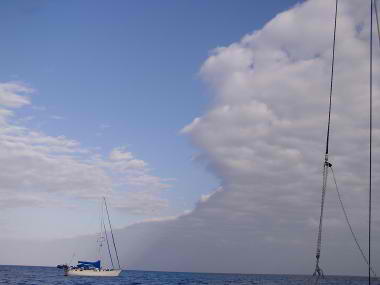Planning on cruising Florida waters? Especially if you plan on anchoring, you need to know the REAL “rules”. Florida boating, anchoring and mooring laws can be complicated and difficult to understand. We’ve personally never encountered any problems, but we plan to do more gunkholing this winter, so it’s always good to know the anchoring regulations.
BoatUS recently updated this flyer to help Florida boaters. As I understand it, this is the most current information. For more information click for BoatUS or Florida Fish and Wildlife Commission Anchoring and Mooring.
You’ll notice that BoatUS recommends you print out a copy of this guide and carry it with you aboard at all times while in Florida waters. That way you’ll know if anyone happens to question your right to anchor, what the real rules are. In addition to printing out the 2013 anchoring information here, you can download the actual BoatUS PDF and print it out:
DOWNLOAD BOAT US PDF 2013 FLORIDA ANCHORING INFORMATION HERE!
2013 Florida Anchoring Information
Courtesy of Boat Owners Association of The United States
In 2009, several changes were made to Florida law (Chapter 327) that increased recreational boaters’ ability to
anchor within the state. This law also outlined a temporary pilot mooring and anchoring program to allow fi ve
localities around Florida to regulate anchoring within their jurisdictions.
This bulletin is intended to help boaters and local law enforcement understand Florida’s anchoring and mooring
laws, and the status of the mooring pilot project.
Can local governments restrict me from anchoring?
Under Florida law, boaters who use their boats for navigation (even if only occasionally) cannot be restricted from anchoring by a local jurisdiction (city or county) outside of permitted mooring fields. Cities and counties are expressly forbidden to “enact, continue in effect, or enforce any ordinance or local regulation … regulating the anchoring of vessels other than live-aboard vessels
outside the marked boundaries of mooring fields.” (Note definition of live-aboard below.) Local governments may regulate anchoring within the marked boundaries of properly permitted mooring fields.As of September 2012 these are: Key West Mooring Field, Ft. Myers Beach Mooring Field, Fernandina Beach Municipal Mooring Field, Miami Dinner Key Mooring Field, City of St. Augustine Mooring Field, Titusville City Mooring Field, City of Sarasota Mooring Field, City of St. Petersburg Mooring Field, City of Naples Mooring Field, City of Punta Gorda Mooring Field, and Fort Myers Beach Mooring Field.
(Existing FL law) 327.60 Local regulations; limitations —
Nothing in this section shall be construed to prohibit local governmental authorities from the enactment or enforcement of regulations which prohibit or restrict the mooring or anchoring of floating structures or live-aboard vessels within their jurisdictions or of any vessels within the marked boundaries of mooring fi elds permitted as provided in s. 327.40. However, local
governmental authorities are prohibited from regulating the anchoring outside of such mooring fields of vessels other than live-aboard vessels as defined in s. 327.02. The exception to this restriction are the fi ve localities currently participating in the mooring and anchoring pilot program which are permitted to regulate anchoring in their jurisdictions (see other side for additional
information on the pilot program.)
Does it matter if I “live-aboard” my vessel?
Full time, active cruisers who sleep on their boats with no permanent residence on land are no longer considered
live-aboards under this law. As a result, their anchoring cannot be regulated by local governments. It is no longer
relevant that the vessel is a boater’s “legal residence,” that term has been removed from the statute.
(from Chapter 2009-86, section 6)327.02 Definitions of terms used in this chapter and in chapter 328.- As used in this chapter and
in chapter 328, unless the context clearly requires a different meaning, the term: (17)
”Live-aboard vessel” means: a) Any vessel used solely as a residence and not for navigation;
b) Any vessel represented as a place of business, or a professional or other commercial enterprise;
or c) Any vessel for which a declaration of domicile has been fi led pursuant to s. 222.17.
CARRY THIS GUIDE WITH YOU WHILE CRUISING IN FLORIDA AND SHARE WITH FELLOW BOATERS.This document has been reviewed by the Florida Fish and Wildlife Conservation Commission however such review is not to be considered an endorsement or approval. September 2012
What is the status of the mooring field pilot studies?
As defined in Florida statute 327.4105, the goals of the temporary pilot program are to encourage the
establishment of additional public mooring fields and to test policies that promote public access, enhance
navigational safety, protect maritime infrastructure and the environment, and deter improperly stored,
abandoned, or derelict vessels. To date, four locations have enacted a local anchoring ordinance:
• City of St. Augustine
• Monroe County (Florida Keys)
• City of Sarasota
• City of St. Petersburg
At press time, the fifth location, Martin County/City of Stuart, is still drafting their ordinance. Each of these
locations has developed a different approach to regulating anchoring of non live-aboard boats. For a summary of
each location’s regulations and other updates, please visit www.boatus.com/gov/floridaanchoring.asp.
Can anchoring be limited close to these new moorings?
Yes. The five areas selected for participation in the pilot program may “regulate by ordinance the anchoring of
vessels, other than live-aboard vessels as defined in s. 327.02, outside of a mooring field.” BoatU.S. has worked
closely with the cities and counties and the Florida Fish and Wildlife Commission on the development of these local
regulations to protect the interests of active, responsible boaters. We encourage boaters to become familiar with
these local regulations and provide BoatU.S. with your feedback on how they are working.
It is important to note that the 2009 legislation that created the pilot program and the five counties’ ability to
enact local regulation was written with an expiration date of July 1st, 2014. All local ordinances enacted under
this section “shall expire concurrently with the expiration of the pilot program and shall be inoperative and
unenforceable thereafter” unless they are reenacted by the Florida Legislature.
For updates on this topic please visit www.boatus.com/gov
As BoatUS advises, you may want to print out this guide and familiarize yourself with the designated mooring fields. We just encountered this in Sarasota with the Marina Jack’s office trying to tell us that we were not allowed to anchor outside the mooring field (even though there were clearly a dozen or more boats anchored there) and the unfriendly office staff directed us to a local policeman, who was conveniently unavailable.
Anyone with updated experiences with anchoring in Florida that wants to share? Please leave a comment and let us know the details! Cheers! Jan














I would like some concrete information about anchoring and cruising in Hawaii. Our cruising book is the latest edition on the MeHaffey’s cruising book(7-8 years old). Department of Land and Natural Resources will ask where you’ve been if they come in contact with you and charge you their fee plus a $2.00 per day per person live aboard fee for anywhere you anchor. It seems a high price to pay ($600.00/month if it’s only $20.00/day-depending on the size of your vessel-to anchor and receive no amenities. No electric, showers, water, etc. Anyone have any real info on Hawaii??
Sorry Stacy, I have no first hand info on anchoring in Hawaii. You might try asking on http://www.cruisersforum.com or noonsite.com. Both are usually pretty current. Good luck! Cheers — Jan
Great post, thanks for the read.